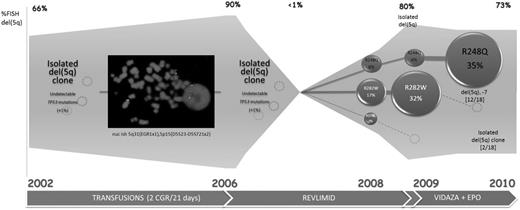Abstract
Landscape analyses of mutational patterns have shown that virtually all myelodysplastic syndromes (MDS) harbor somatic mutations in >80% of cases. These molecular alterations provide useful clonality markers with a potential for early diagnosis of MDS when only cytopenia without marked dysplasia is observed. These markers have been proposed as future prognostic tools to guide therapeutic strategies (Bejar et al., 2011; Itzykson et al, 2013; Mufti et al 2013). Mutational analysis is finally a good way to track disease complexity by deciphering oligoclonality in MDS and better understand clonal evolution.
Alterations in the TP53 gene are the most common cause of tumor escape from apoptosis. The aim of this study was to identify TP53 mutations in consecutive samples of lower-risk MDS (IPSS ≤1) with del(5q)obtained at follow-up or progression after sequential classical treatments. Next-generation sequencing (NGS) was used to backtrack the mutant clone(s) identified in late samples.
The study was performed both by conventional Sanger sequencing and NGS on a GS Junior Instrument (Roche Applied Science, Mannheim, Germany). For each sample, eight exons (4-11) were amplified from 320 ng of DNA with preconfigured primer plates provided within the IRON II study network. PCR reactions were performed using the FastStart High Fidelity PCR System kit (Roche Applied Science). After double purification with Agencourt AMPure XP beads (Beckman Coulter, Miami, FL), exon-specific amplicon pools were generated and quantified using the Quant-iT™ Broad-Range PicoGreen DNA Assay Kit (Invitrogen, Carlsbad, CA). Emulsion PCR was performed with GS Junior emPCR Reagents (Lib-A) (Roche Applied Science) using 5 x 106 beads at a copy per bead ratio of 0.6. Finally, a fraction of 5-7% enriched beads was loaded on GS Junior Titanium sequencing PicoTiterPlate kit (Roche Applied Science). Data were analyzed for sequence alignment and variant detection using the GS Junior Sequencer and GS Amplicon Variant Analyzer softwares, versions 2.7 and 2.9 (Roche Applied Science). The results were further processed using the Sequence Pilot software version 4.0.1 (JSI Medical Systems, Kippenheim, Germany). The sensitivity of variant detection was set to a lower limit of >1% for bidirectional reads. This threshold was chosen according to a recent study investigating the assay's lower limit of detection (Grossmann et al., 2013), thus underlining the strength of NGS to identify subclones at a low frequency, not detectable by conventional Sanger analysis.
A total of 89 DNA samples were extracted from the cytogenetics pellets of a cohort of 40 MDS with del(5q). TP53 mutation analysis was performed on 40 initial and 49 follow-up or progression samples including serial samples for 23 subjects.
The depth of coverage was at least 500X and up to 8,444X per amplicon. Of those samples obtained and analysed at time of last follow-up or progression, 14 (61%) had TP53 mutations, mostly in the DNA-binding domain. Performing backtracking on previously collected serial samples, TP53 mutations were retrieved by NGS in 43% of initial samples (n=6), which is different from what was previously described by Jädersten et al (2011). A complete scenario of clonal evolution was retrieved in 11 cases, evidenced by TP53 mutations and/or cytogenetics. These were always consecutive to treatment with lenalidomide, yet 6 of the 12 cases without clonal evolution were also consecutive lenalidomide. Figure 1 provides the example of a complete follow-up including nine time points. More correlation with treatment will be provided. Although lenalidomide remains the treatment of choice for MDS with del(5q), resistant subclones may survive and culminate even following therapy initiation. This theory was recently suggested by Landau et al. in CLL (2013) and our test results support this.
Early detection of emerging subclones could lead to initiation of alternative treatment, and we thus propose that a monitoring of TP53 alleles is performed annually after the onset of therapy for MDS using NGS.
Kohlmann:MLL Munich Leukemia Laboratory: Employment. Moreau:CELGENE: Honoraria, Speakers Bureau; JANSSEN: Honoraria, Speakers Bureau.
Author notes
Asterisk with author names denotes non-ASH members.


This feature is available to Subscribers Only
Sign In or Create an Account Close Modal